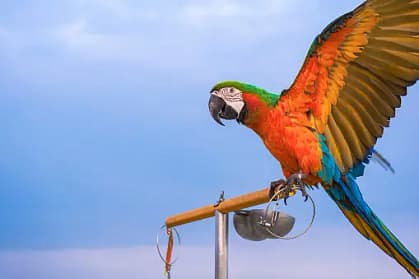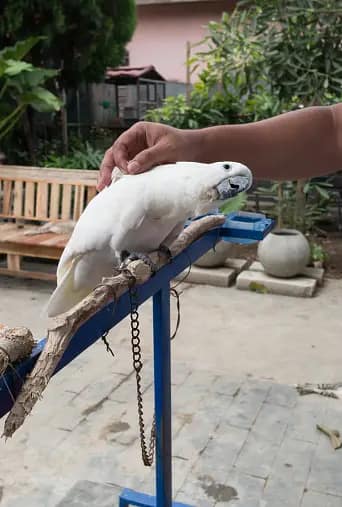I: Introduction
Employing effective positive reinforcement techniques for birds is crucial to cultivating a harmonious and rewarding relationship with these intelligent and social creatures. Through the application of these techniques, bird owners can encourage desirable behaviors, strengthen the bond with their feathered companions, and ensure a joyful and fulfilling life for their avian friends.
Positive reinforcement is a training method that focuses on rewarding desired behaviors rather than punishing unwanted ones. This approach encourages birds to repeat behaviors that result in positive outcomes, such as treats, praise, or attention. By using positive reinforcement, bird owners can shape their pets’ behaviors and establish a strong foundation for further training and development.
Setting clear training goals is crucial when implementing positive reinforcement techniques. Bird owners should identify specific behaviors they want to encourage, such as stepping onto a hand or speaking on command. By clearly defining these goals, owners can create a structured training plan and track their bird’s progress.
Rewards and treats play a significant role in positive reinforcement training. Birds are highly motivated by food, so using their favorite treats as rewards can be highly effective. By associating desired behaviors with treats, bird owners can reinforce positive actions and motivate their pets to continue performing them.
Clicker training is a popular technique used in positive reinforcement training for birds. It involves using a clicker, a small handheld device that makes a distinct clicking sound, to mark desired behaviors. By pairing the click with a reward, such as a treat, birds learn to associate the sound with positive outcomes, making it easier for owners to communicate their expectations.
Consistency and timing are essential factors in positive reinforcement training. Bird owners must be consistent in their approach, rewarding desired behaviors every time they occur. Additionally, rewards must be given immediately after the behavior to ensure a clear association between the action and the reward.
Building trust and bonding with a pet bird is crucial for successful positive reinforcement training. Spending quality time with the bird, providing social interaction, and creating a safe and stimulating environment can help establish a strong bond. A trusting relationship enhances the bird’s willingness to learn and cooperate during training sessions.
Shaping desired behaviors involves breaking down complex actions into smaller, manageable steps. By rewarding each small step towards the desired behavior, bird owners can gradually shape their pet’s actions and reinforce progress along the way.
Avoiding punishment is an important principle of effective positive reinforcement techniques for birds. Punishment can create fear and anxiety in birds, leading to negative associations with training and hindering their progress. Instead, focusing on rewarding positive behaviors and redirecting
II: Understanding Positive Reinforcement
Positive reinforcement is a powerful tool in training and shaping behaviors in pet birds. It involves providing rewards or incentives to encourage and reinforce desired behaviors. This technique focuses on promoting positive experiences and creating a strong bond between the bird and its owner.
To properly use effective positive reinforcement techniques for birds, it is important to understand the principles behind it. Positive reinforcement works by associating a behavior with a pleasant consequence, which increases the likelihood of the behavior being repeated in the future. This means that when a bird exhibits a desired behavior, it should be immediately followed by a reward or treat to reinforce the behavior.
When using positive reinforcement, it is crucial to choose the right rewards for your bird. Different birds have different preferences, so it is important to find out what motivates your feathered friend. Some common rewards include treats, praise, petting, or access to a favorite toy or activity. By using rewards that your bird finds highly desirable, you can strengthen the positive association with the desired behavior.
Consistency is key when using positive reinforcement techniques. It is important to consistently reward the desired behavior every time it occurs. This helps the bird understand that the behavior is being reinforced and increases the likelihood of it being repeated. Inconsistency can lead to confusion and make it difficult for the bird to understand what is expected of them.
Timing is also crucial in positive reinforcement. The reward should be given immediately after the desired behavior occurs, so the bird can make the connection between the behavior and the consequence. Delaying the reward may cause the bird to associate the reward with a different behavior or not understand why they are being rewarded.
Positive reinforcement can be used to shape desired behaviors in birds. This involves breaking down the desired behavior into smaller steps and rewarding each step along the way. By gradually shaping the behavior, the bird can learn and understand what is expected of them, making the training process more effective.
It is important to note that positive reinforcement should always be used in conjunction with building trust and bonding with your bird. A strong and trusting relationship is the foundation for successful training. By using positive reinforcement techniques, you can create a positive and rewarding experience for both you and your feathered companion.
III: Setting Clear Training Goals
Setting clear training goals is an essential step in effective positive reinforcement techniques for birds. Without clear goals, it can be challenging to track progress and ensure that you are on the right path towards achieving the desired behaviors. Here are some key points to consider when setting training goals for your feathered friend:
1. Identify specific behaviors:
Start by identifying the specific behaviors that you want to reinforce in your bird. This could include behaviors such as stepping up onto your hand, speaking certain words or phrases, or even performing tricks. By clearly defining these behaviors, you can focus your training efforts and measure progress more effectively.
2. Break it down:
Once you have identified the desired behaviors, break them down into smaller, manageable steps. This allows you to gradually work towards the ultimate goal and helps prevent your bird from becoming overwhelmed. For example, if you want your bird to learn to speak certain words, start by teaching them one word at a time before moving on to the next.
3. Set realistic timelines:
It is important to set realistic timelines for achieving your training goals. Birds, like any other animals, have their own learning pace, and rushing the process can lead to frustration for both you and your bird. Be patient and allow your bird the time it needs to understand and master each step.
4. Use positive reinforcement:
When setting training goals, it is crucial to focus on positive reinforcement techniques. Positive reinforcement involves rewarding your bird for exhibiting the desired behavior, which increases the likelihood of them repeating it in the future. This can be done through verbal praise, treats, or even a favorite toy. By associating the desired behavior with a positive outcome, you are encouraging your bird to continue performing that behavior.
5. Track progress:
Keep track of your bird’s progress towards the training goals. This can be done through a training journal or by using a training app specifically designed for bird owners. By documenting your bird’s achievements and setbacks, you can identify any areas that may require additional attention and adjust your training strategies accordingly.
Setting clear training goals is crucial in effectively reinforcing positive behaviors in pet birds. By breaking down the desired behaviors, setting realistic timelines, using positive reinforcement techniques, and tracking progress, you can create a structured training plan that promotes a positive and rewarding relationship with your avian companion.
IV: Using Rewards and Treats
One of the most effective positive reinforcement techniques for birds is the use of rewards and treats. Birds, like many animals, respond well to rewards and positive reinforcement. By offering treats and rewards, you can encourage and reinforce desired behaviors in your pet bird.
When using rewards and treats, it is important to choose ones that your bird finds highly motivating. This could be a favorite food item, such as a small piece of fruit or a nut. It is important to note that treats should be given in moderation to prevent overfeeding and potential health issues.
To effectively use rewards and treats, you should begin by identifying the specific behaviors you want to reinforce in your bird. For example, if you want to teach your bird to step onto your hand, you can offer a treat each time they successfully do so. This positive association between the behavior and the reward will help your bird understand what is expected of them.
Timing is crucial when using rewards and treats. It is important to deliver the reward immediately after the desired behavior occurs. This helps your bird make the connection between the behavior and the reward. If you wait too long to give the reward, your bird may not understand what they are being rewarded for.
Consistency is also key when using rewards and treats. Make sure to consistently reward your bird for the desired behavior each time they perform it. This helps reinforce the behavior and encourages your bird to continue engaging in it.
It is important to note that rewards and treats should be used in conjunction with other positive reinforcement techniques. This helps create a well-rounded training approach and ensures that your bird understands and responds to a variety of reinforcement methods.
By using rewards and treats effectively, you can promote positive behaviors in your pet bird and strengthen your bond with them. Remember to choose motivating rewards, deliver them promptly, and be consistent in your reinforcement. With patience and consistency, you can successfully train your bird using positive reinforcement techniques.

V: Clicker Training Techniques
Clicker training is a popular and effective positive reinforcement technique that can be used to train and reinforce desired behaviors in pet birds. This technique involves using a small handheld device called a clicker, which makes a distinct clicking sound when pressed. The clicker serves as a signal to the bird that it has performed the desired behavior correctly and will be rewarded.
To begin clicker training, it is important to first associate the sound of the clicker with a positive experience for the bird. This can be done by pairing the clicker sound with a treat or reward. For example, every time you press the clicker, immediately follow it with giving your bird a small treat. Repeat this process several times until the bird begins to associate the clicker sound with receiving a reward.
Once the bird has made the association between the clicker sound and receiving a reward, you can begin using the clicker as a tool to reinforce specific behaviors. When your bird performs a desired behavior, such as stepping onto your hand or performing a trick, immediately press the clicker and then provide a treat or reward. The clicker serves as a clear and consistent signal to the bird that it has done something right and will be rewarded.
Clicker training allows for precise timing and communication with your bird. The clicker sound is instantaneous and can mark the exact moment the desired behavior occurs, making it easier for the bird to understand what it is being rewarded for. This technique also helps to eliminate any confusion or ambiguity in the training process.
It is important to note that clicker training should always be followed by a reward or treat. The clicker itself does not serve as a reward, but rather as a signal that a reward is coming. This helps to reinforce the positive association between the desired behavior and the reward.
In conclusion, clicker training is an effective positive reinforcement technique for training and reinforcing desired behaviors in pet birds. By using a clicker to mark the desired behavior and providing a reward or treat, you can create a positive and rewarding training experience for your feathered friend.
VI: Consistency and Timing
Consistency and timing are crucial elements when it comes to effective positive reinforcement techniques for birds. Consistency refers to the need for a trainer to consistently apply the same rules and expectations in their interactions with their feathered friend. This means that if a certain behavior is desired, the trainer should always respond in the same way to reinforce that behavior. For example, if a bird is being trained to step onto a perch, the trainer should consistently reward the bird with a treat or praise every time it successfully steps onto the perch.
Timing is equally important in positive reinforcement training. The trainer must provide the reward or reinforcement immediately after the desired behavior is exhibited. This is because birds have a short attention span and may not associate the reward with the behavior if there is a delay. By providing the reinforcement immediately, the bird can make a clear connection between its behavior and the reward, increasing the likelihood of repeating the desired behavior in the future.
To ensure consistency and timing, it is helpful to establish a training routine and stick to it. Set aside regular training sessions with your bird, keeping them short and focused. This will help both you and your bird stay engaged and maintain consistency in your training efforts. Additionally, it is important to be patient and persistent. Birds, like any other animals, may take time to learn and understand the desired behaviors. Consistency and timing will help reinforce these behaviors over time.
It is also important to note that positive reinforcement should not be limited to training sessions alone. Reinforcing good behavior in everyday life is equally important. Whenever your bird exhibits a desired behavior outside of training sessions, such as staying calm during a vet visit or interacting peacefully with other pets, be sure to provide immediate praise or a small reward. This will help reinforce the behavior and encourage your bird to continue behaving positively in different situations.
In conclusion, consistency and timing are essential in effectively reinforcing positive behaviors in birds. By consistently applying the same rules and expectations, and providing immediate rewards or reinforcements, you can create a positive and rewarding relationship with your feathered friend. Remember to establish a training routine, be patient and persistent, and reinforce good behavior in everyday life to further strengthen the bond with your bird.

VII: Building Trust and Bonding
Building trust and bonding is crucial to build effective positive reinforcement techniques for birds. Birds are highly intelligent and social creatures, and they thrive in environments where they feel safe and secure. Here are some techniques to help you build trust and strengthen your bond with your feathered friend:
1. Spend Quality Time Together:
Dedicate regular, uninterrupted time to spend with your bird. This can include activities such as talking to them, playing games, or simply sitting near their cage. By consistently being present and engaging with your bird, you will build a sense of trust and companionship.
2. Respect Personal Space:
Birds, like humans, have their own personal space and boundaries. It is important to respect these boundaries and not force interactions. Allow your bird to approach you at their own pace and avoid overwhelming them with too much physical contact initially. Gradually, as trust is established, you can increase physical interactions.
3. Positive Reinforcement:
Use positive reinforcement techniques to reward and reinforce desired behaviors. When your bird displays a behavior you want to encourage, such as stepping onto your hand or playing with a specific toy, offer praise, treats, or other rewards. This positive association will strengthen the bond between you and your bird.
4. Gentle Handling:
When handling your bird, always be gentle and avoid any sudden movements or actions that may startle or frighten them. Use a calm and reassuring tone of voice and move slowly and deliberately. This will help your bird feel safe and secure in your presence.
5. Respect Body Language:
Birds communicate through body language, and it is important to learn and respect their signals. Pay attention to your bird’s body posture, vocalizations, and eye movements to understand their mood and level of comfort. This will help you adjust your interactions accordingly and avoid any potential stress or fear triggers.
6. Create a Safe Environment:
Provide a safe and stimulating environment for your bird to thrive in. This includes a spacious cage with plenty of toys, perches, and hiding spots. Regularly clean and maintain the cage to ensure a hygienic and comfortable living space for your bird.
Building trust and bonding with your pet bird takes time and patience. By consistently implementing these techniques and providing a nurturing environment, you will establish a strong foundation for effective positive reinforcement training and create a loving and rewarding relationship with your avian companion. For some fun, interactive bird bonding games to try, check out our Top 5 Interactive Games for Bonding with Your Bird.
VIII: Shaping Desired Behaviors
Shaping desired behaviors is an essential aspect of effective positive reinforcement techniques for birds. This technique involves breaking down the desired behavior into small, manageable steps and reinforcing each step along the way. By gradually shaping the behavior, you can effectively train your bird to perform complex tasks or actions.
To begin shaping a behavior, start with a simple action that your bird already knows or is likely to perform naturally. For example, if you want to teach your bird to step onto your hand, you can start by reinforcing any movement towards your hand, such as leaning towards it or extending a foot in its direction. Each time your bird exhibits the desired behavior, provide immediate positive reinforcement, such as praise or a treat.
As your bird becomes more comfortable with the initial step, gradually raise the criteria for reinforcement. For example, you can now require your bird to actually touch your hand with its foot before receiving a reward. Continue to raise the criteria incrementally until your bird is consistently stepping onto your hand.
It is important to note that shaping desired behaviors requires patience and consistency. It may take several training sessions for your bird to fully grasp and perform the behavior you are shaping. Be sure to provide clear and consistent cues or signals to help your bird understand what is expected of it.
In addition to shaping desired behaviors, it is equally important to reinforce and reward your bird for its efforts and progress. Even if your bird does not fully achieve the desired behavior, acknowledge its attempts and provide positive reinforcement. This will encourage your bird to continue trying and learning.
Remember to always end each training session on a positive note, even if progress is slow. Celebrate your bird’s accomplishments and provide plenty of praise and rewards. This will help create a positive and rewarding training experience for both you and your feathered friend.
By using shaping techniques and providing consistent positive reinforcement, you can effectively train your bird to perform desired behaviors and strengthen your bond with them. With patience, consistency, and a focus on positive reinforcement, you can unlock the secrets of effective bird training techniques and enjoy a rewarding relationship with your avian companion.
IX: Avoiding Punishment
When it comes to training and reinforcing positive behaviors in birds, it is important to avoid using punishment as a means of correction. Punishment can be detrimental to the trust and bond between you and your feathered friend, and it may even lead to fear and aggression. Instead, focus on using positive reinforcement techniques to encourage desired behaviors.
One way to avoid punishment is to redirect your bird’s behavior. If your bird is engaging in an undesirable behavior, such as biting or screaming, instead of scolding or punishing them, redirect their attention to a more appropriate behavior. For example, if your bird is biting, offer them a toy or a treat to chew on instead. By redirecting their behavior, you are teaching them what is acceptable and providing them with an alternative outlet for their energy.
Another important aspect of avoiding punishment is to be patient and understanding. Birds, like any other animal, have their own unique personalities and learning styles. It may take time for them to understand and respond to the training techniques you are using. It is important to remain patient and consistent in your approach, and to avoid getting frustrated or angry with your bird. Remember, positive reinforcement is about building a positive and rewarding relationship with your bird, and punishment can undermine that goal.
Additionally, it is important to create a safe and enriched environment for your bird. Birds are intelligent and curious creatures, and they thrive in environments that provide them with mental and physical stimulation. Make sure your bird has plenty of toys, perches, and opportunities for play and exploration. This will help prevent boredom and reduce the likelihood of engaging in undesirable behaviors.
In conclusion, when it comes to training and reinforcing positive behaviors in birds, it is important to avoid punishment and focus on using positive reinforcement techniques. By redirecting your bird’s behavior, being patient and understanding, and creating a safe and enriched environment, you can promote desired behaviors and strengthen the bond between you and your feathered friend. Remember, training is a journey, and with time and consistency, you can unlock the secrets of effective bird training techniques.
X: Reinforcing Good Behavior in Everyday Life
Reinforcing good behavior in everyday life is an essential aspect of effective positive reinforcement techniques for birds. It involves consistently rewarding and acknowledging desired behaviors to encourage their repetition and strengthen the bond between you and your feathered friend.
One of the key strategies for reinforcing good behavior is to provide immediate and consistent rewards. Birds are intelligent creatures and can quickly associate their actions with the consequences that follow. Therefore, it is crucial to reward their positive behaviors promptly to reinforce the connection between the behavior and the reward.
Rewards can come in various forms, including treats, praise, and physical affection. It is important to understand what motivates your bird and use those incentives effectively. Some birds may be food-motivated, while others may respond better to verbal praise or a gentle pat on the head. Experiment with different types of rewards to determine what works best for your bird.
Consistency is another vital factor in reinforcing good behavior. Birds thrive on routine and predictability, so it is essential to establish consistent expectations and rewards. For example, if you want to encourage your bird to step onto your hand, always use the same command and reward them with a treat or praise when they comply. Consistency helps birds understand what is expected of them and reinforces the desired behavior.
In addition to immediate rewards and consistency, it is important to reinforce good behavior throughout the day. Look for opportunities to reward your bird for positive actions, even outside of formal training sessions. For example, if your bird is playing quietly in their cage or perching calmly on their stand, offer them a treat or a kind word to reinforce their good behavior.
It is also important to avoid punishment when reinforcing good behavior. Birds are sensitive creatures, and punishment can lead to fear, stress, and a breakdown in trust. Instead, focus on positive reinforcement techniques that reward and encourage the behaviors you want to see more of.
By consistently reinforcing good behavior in everyday life, you can create a positive and rewarding relationship with your bird. Remember to be patient and understanding, as training takes time and effort. With effective positive reinforcement techniques for birds, you can unlock the secrets to successful bird training and enjoy a strong bond with your avian companion.

